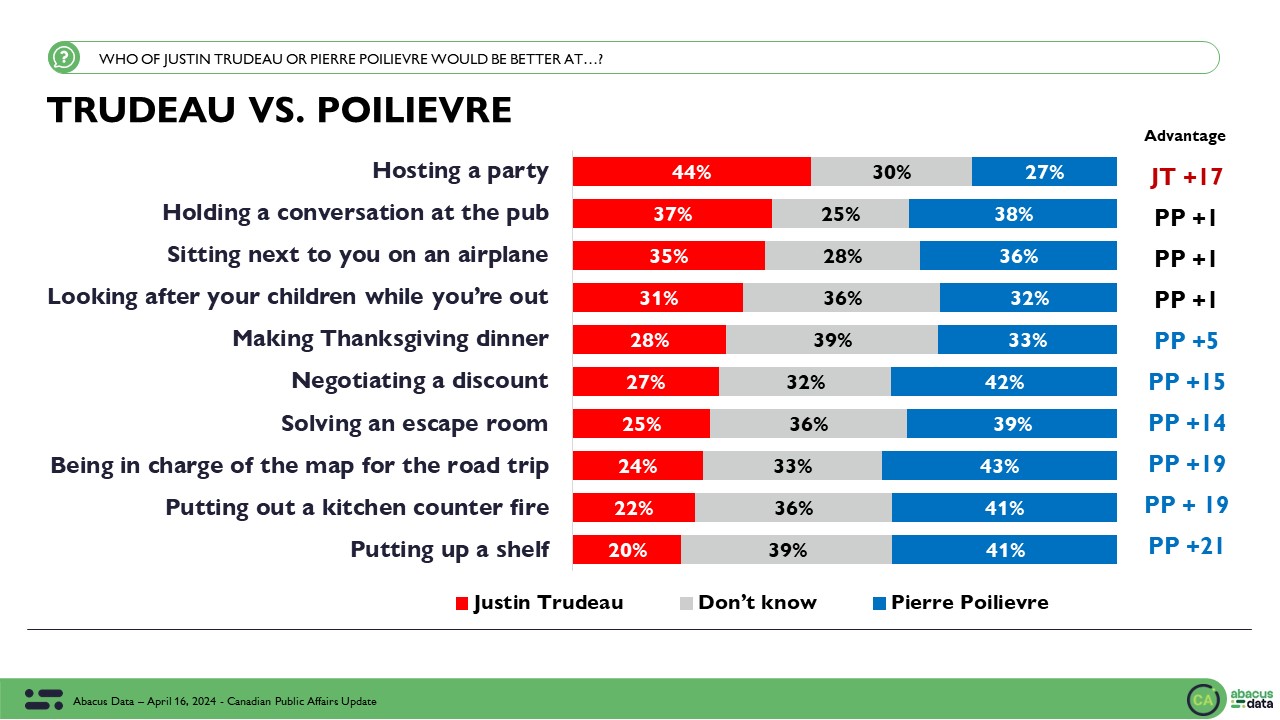Liberal slippage halts with an uptick on some key indicators
November 16, 2017


Last month we saw a four-point slip in Liberal Party support; in our latest survey the Liberals have stabilized and would win 40% support today. The Conservatives are at 32%. Both these numbers are identical to the results last election Day in 2015.
In the three seat richest provinces, the Liberals have a 6-point lead in Ontario, a 26-point lead in Quebec, and are tied with the NDP in BC. Healthy gains are evident for the NDP in BC, apparently at the expense of both the Liberals and Conservatives. Over the next month or two, we will closely monitor this shift to see if it is sustained, and if so, to what degree it has to do with positive feelings about Mr. Singh, less positive feelings about the Trudeau government, or a spillover of positive NDP sentiment from the provincial level.


The Liberals lead among all age groups except for those 60 and over. Much of the Liberal lead nationally is thanks to its margin among those under 45. We have seen a boast in support for the NDP among those under 30, up 15 from last month.

About half (49%) say the country is headed in the right direction, the highest number in a year and up 6-points from October’s dip. 29% say Canada is off on “the wrong track”.

Approval of the federal government has also recovered from the 7-point drop noted last month. Today, 47% approve of the job the Trudeau government is doing, while 34% disapprove. This is closer to what we have tracked since the beginning of 2017.

Approval of the government is the plurality view in every place but Alberta and Saskatchewan and among all age groups under 60. 40% of those who voted NDP in 2015 approve of the Trudeau government performance while 75% of Liberal voters approve compared with 11% who disapprove.
Impressions of Mr. Trudeau’s are stable with 48% saying they have a positive view of the PM, 31% have a negative impression.
For Mr. Scheer, his positives rose 4-points, but his negatives rose 7-points over the last month.
For Mr. Singh, his positives are up by 5, and now has 23% positive, 19% negative opinion – marking the first time since March that the NDP has had a leader with higher positive than negative opinion.

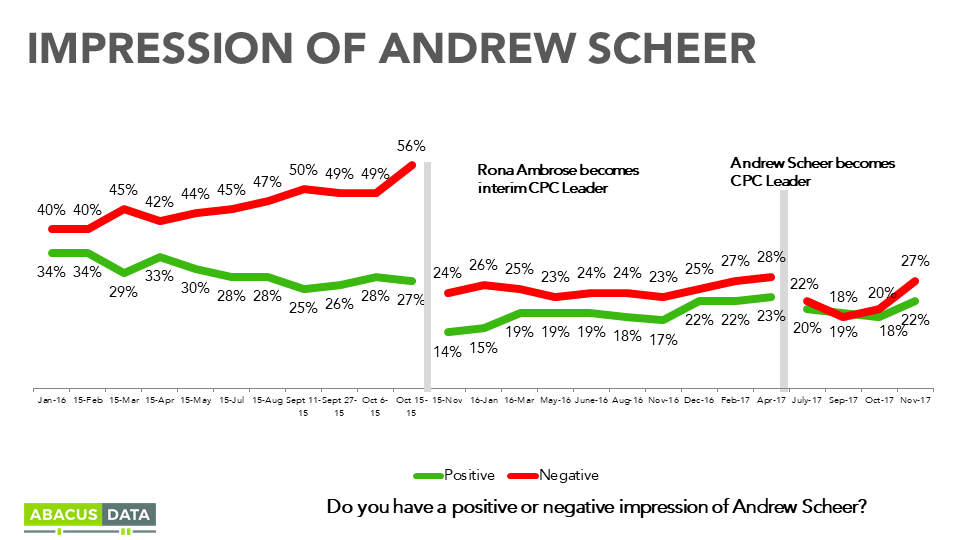

Regionally, Mr. Trudeau has the highest net positive ratings in all regions except for the Prairies. Almost half in BC and Ontario have positive views of the Prime Minister while a majority in Quebec and two thirds in Atlantic Canada feel positively about Mr. Trudeau.
Mr. Scheer is strongest in the Prairies where he has a net positive impression of +13. His impression in Ontario is about even with 23% having a positive impression and 26% having a negative impression.
Mr. Singh is viewed positively in Ontario and British Columbia (+8) and is net neutral in other regions. In Quebec, more people view Mr. Singh positively than Mr. Scheer (21% vs. 16%).

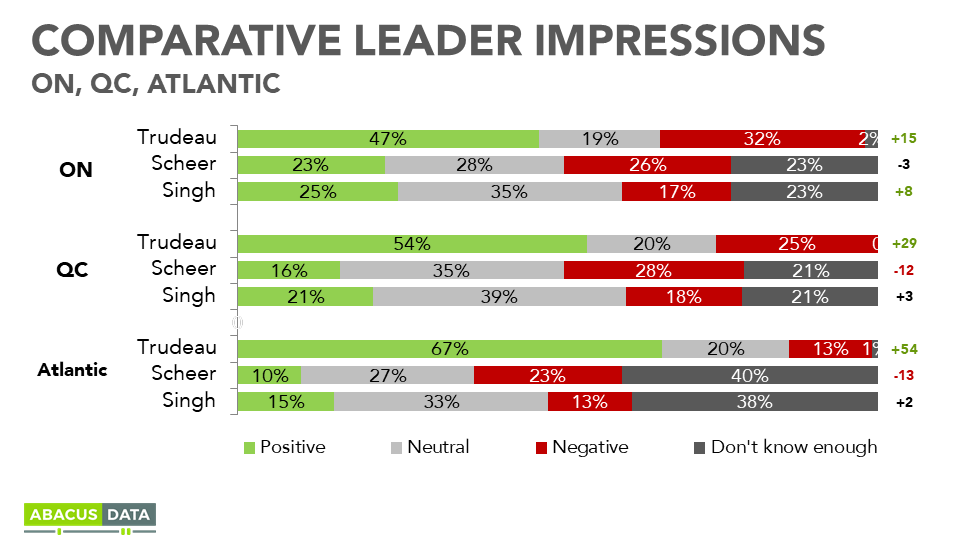
Over the next two years, we will also track impressions among three key groups of voters: Millennials, women, and those living in urban centres.
Among all three groups, Mr. Trudeau has held an edge over the other party leaders since the beginning of 2016. It’s worth keeping in mind for much of that time, the Conservative Party had an interim leader and Tom Mulcair was voted out by party members at the convention in Edmonton in early 2016.
As with impressions of Mr. Trudeau among all voters, there has been a softening of his image among these three groups. In January 2016, Mr. Trudeau had net positive scores of +47 among Millennials, +36 among women, and +33 among urban residents. Today, his numbers remain positive but the gap between those having a positive and negative impressions has shrunk in all three cases.
For the two new opposition leaders, Mr. Singh’s numbers are headed in a positive direction (after two months of our tracking) while Mr. Scheer’s are becoming more negative among Millennials and urban dwellers.
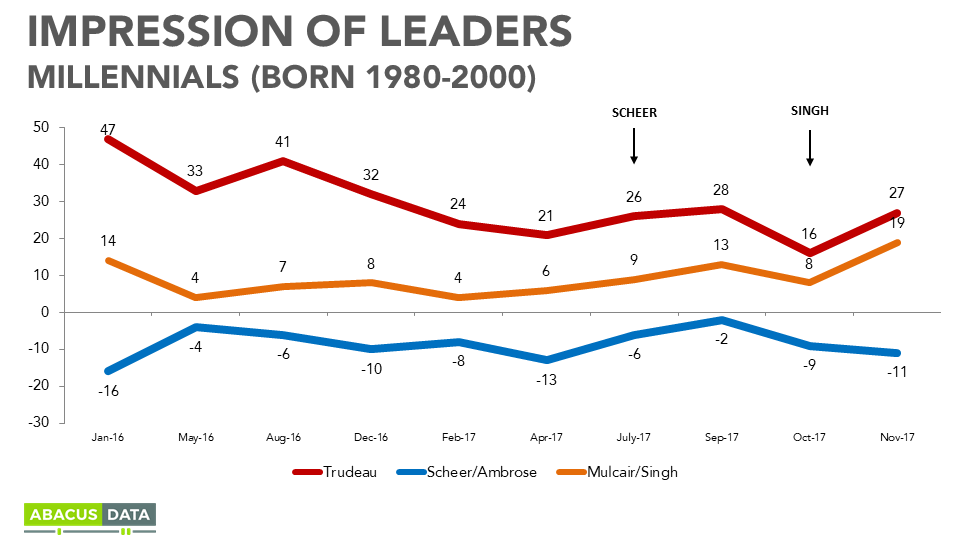

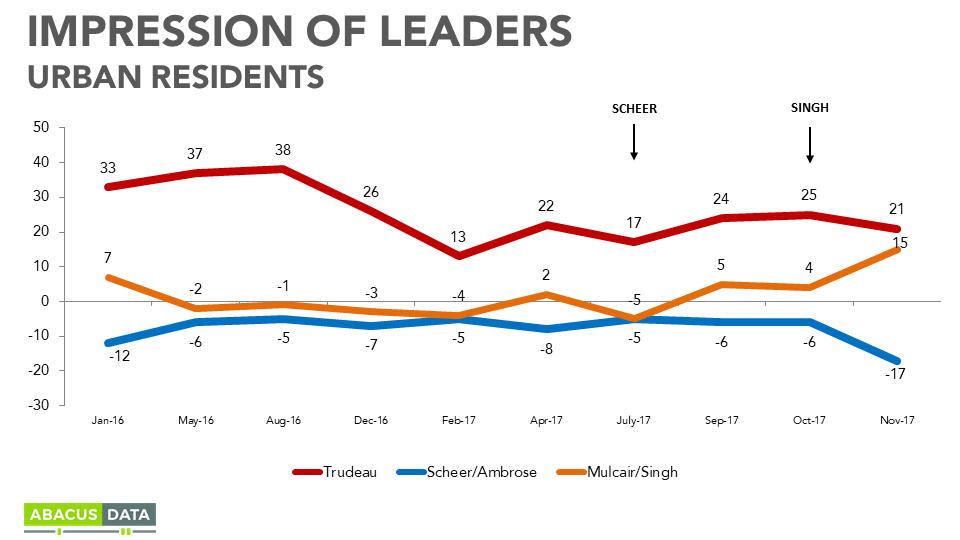
UPSHOT
According to Bruce Anderson: “We’re shifting towards a new evaluative framework, one where voters spend less time comparing the Trudeau government to the Harper government, or to their expectations of Mr. Trudeau, and as time goes on, more time comparing Mr. Trudeau’s Liberals to the Conservatives under Mr. Scheer’s leadership and the Singh-led NDP. In that context, current levels of comfort with the direction of the country and the health of the economy are buttresses for Liberal support.
For the Conservatives, no longer having Mr. Harper as leader has opened new opportunities, but it’s too soon to say whether Mr. Scheer looks like the kind of leader who can capitalize on these opportunities.
For the NDP, the shift from Mr. Mulcair to Mr. Singh has also been a positive one, and the spring in their numbers in BC will provide some encouragement for NDP partisans. The big challenges for the NDP are whether they can recover lost ground in Quebec and whether they can avoid being squeezed out in a polarized battle between progressive and conservative voters in Ontario.
According to David Coletto: “Last month we saw a more competitive political environment than at any point since the last election. This month, the environment is less competitive with the Liberals re-opening a healthy 8-point lead over the Conservatives. Our topline numbers are almost exact to the results of the last election.
The fundamentals also remain quite positive for the Liberals. Half the country thinks things are generally headed in the right direction and approval of the federal government has returned to levels we measured in the summer. Mr. Trudeau’s personal image is quite positive, especially among core parts of the Liberal coalition: millennials, women, and urban dwellers.
Mr. Singh has had a good month in our tracking. The NDP is up slightly nationally (thanks to a big boost in BC) and people feel more positively about Mr. Singh himself. He still remains unknown to many Canadians, but his numbers are headed in a positive direction.
The same can’t be said for Mr. Scheer. Despite a tough environment for the Liberals, Conservative support is down slightly since last month and people have become more negative towards Mr. Scheer. Still, few people have a good sense of who Mr. Scheer is so there’s still time to define and introduce himself to Canadians.”
METHODOLOGY
Our survey was conducted online with 1,500 Canadians aged 18 and over between November 10 and 14, 2017. A random sample of panelists was invited to complete the survey from a large representative panel of over 500,000 Canadians.
The Marketing Research and Intelligence Association policy limits statements about margins of sampling error for most online surveys. The margin of error for a comparable probability-based random sample of 1,500 is +/- 2.5%, 19 times out of 20.
The data were weighted according to census data to ensure that the sample matched Canada’s population according to age, gender, educational attainment, and region. Totals may not add up to 100 due to rounding.
ABACUS DATA INC.
We offer global research capacity with a strong focus on customer service, attention to detail and value-added insight. Our team combines the experience of our Chairman Bruce Anderson, one of Canada’s leading research executives for two decades, with the energy, creativity and research expertise of CEO David Coletto, Ph.D.



